Soaked to the bone, off-plan and hitting the wall – tramping plans don’t always work out. This three night mid-winter jaunt in the Ruahine range was one such rain soaked occasion, and my second ever tramp.
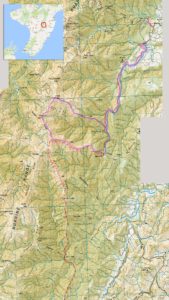
The Ruahine Ranges stretch from the top of the Tararua’s, splitting Hawkes Bay from the Manawatu. Sarah has her eyes set on them, and with the long weekend of Queen’s Birthday ahead she works with friends to sort out some tramps. Her friends split into three parties. For me, recently recovered from the Southern Crossing, the easiest route is suggested; a set of six hour days with plenty of time to smell the flowers. I eagerly accept the offer.
I spend Friday getting ready. I heed my lessons from the Southern Crossing: I pack a dozen museli bars, a dozen chocolate bars and tonnes of nuts. Porridge makes an appearance, and some coffee bags. Two new items join the kit: a headlamp stronger than car headlights and an enamel mug bigger than my head. My prior mug could fit in this three times over; Sarah gave me this beast with the advice ‘you always get more hot water if you have a big mug’.
For lunches I opt for sandwiches and wraps, packed with cheese and salami. They are dry and boring, but dense and effective.
Day 1
Packed and ready, we collect the crew, pile into a car and head over the Rimutakas. We’ve got:
- Me, a keen novice with one overnighter under my belt
- L, a strong silent type, a pro from Germany on his first trip with this lot
- Sarah, well experienced and keen as a bean, and
- B, our well experienced group lead and Sarah’s old friend.
We stop in Masterton for takeaways and pick up groceries for our shared dinners and head another few hours north to Hawkes Bay, to Tikokino and the Ruahine’s to the west.
North Block road is long and progressively worse. The rain patters as we pass through farm gates, plastered with welcome. NO POACHING. YOU ARE BEING RECORDED. NO DOGS. We bounce and weave the labouring Corolla through sheep and turkeys to the park for Triple X hut; a 10 minute walk from the road entry. We don our gear amongst three school vans – we hope their students are elsewhere.
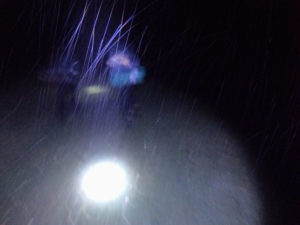
Ten minutes later, the approach to Triple X is littered with tents. The school group is not elsewhere. But they are wonderful kids, lead by a shining star of bush etiquette. Before we’re even in, their leader is kicking boys out of one of the hut’s two bunk rooms (sleeping 6 each) out into a tent with the others. We are tentless, and immensely grateful.
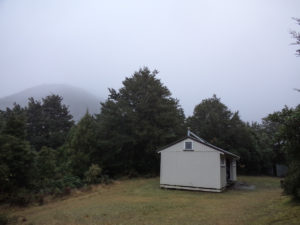
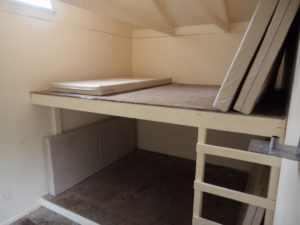

I am happy with my headlamp’s performance; when I point it at the ceiling it’s like a lightbulb in the room. But I’m not so happy with my rain jacket. After our ten minute walk my underclothes are starting to soak; I worry for the day ahead. The forecast for the Ruahine’s is a day of rain. But what is one to do? I try not to worry and retire with the others. One of our other parties is scheduled to arrive later than us, so we cuddle up on the top level, leaving the bottom for them. They never arrive, but I find a cold crevice between mattresses to wedge myself into all night.
In the wee hours I wake and listen to the rain on the tin roof. It’s nice. Later I awake again, and the rain has stopped. But there’s still a pitter patter – I realise they’re little feet. I hope they’re on the roof, not on the exposed beams above my face.
Day 2
We wake in the morning to headlights outside; the kids are setting off early. We lie decadently, listening to the leader chew them out.
‘Denise found this wrapper over there. Who left it there?! That is unacceptable! You don’t leave rubbish in the bush!’
‘Who will take responsibility? Thank you – this is what responsibility looks like, well done Will. And you who left it, you know who you are! You live with that! Let’s go’
and off they went, sullen teenagers in new effective raincoats.
After coffee and porridge (I thank myself for bringing a lot of brown sugar) we pack up and return to the car. Our trailhead is another Corolla-killing kilometre up the road. We head down to the river and jump grand gates to stop the 4×4’s. It is now a track for feet only.
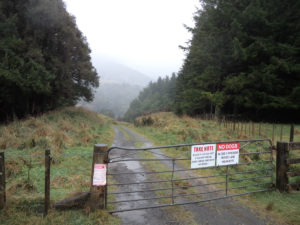
We hop another fence, wave to a video camera and trace the fence separating a deer park from the wilderness. I understand the poaching signs now; where easier to steal a deer and pretend you got it from the range?
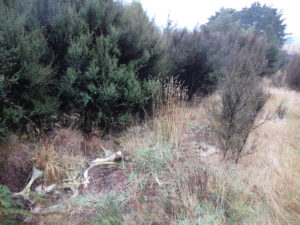
We drop down boggy clay tracks. I enjoy the waterproofing of my new boots; I get an enjoyable hour or so of dry toes before we reach our first river crossing.
True to the forecast, the rain is persistent. The wind is mercifully absent, but the rain is unrelenting; the stream is up and there’s no way to keep dry.
On the other side, we break. I remove my boots and wring my socks; the others watch me with curiosity. Later I learn the futility of this endeavour – the others just accept the new, numb normal for their toes.
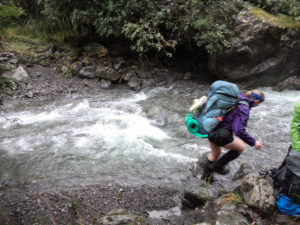
We climb 300metres to an open area. The decaying husks of trees are beautiful, even in the wet.
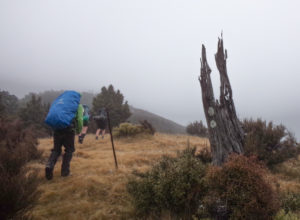
The persistent rain encourages us on, and we trudge. Reaching our peak of the day at 1100metres, we drop 200 heading down to Smith Stream. I lag at times; L is a sport and stays behind me. ‘The least experienced shouldn’t go last’.
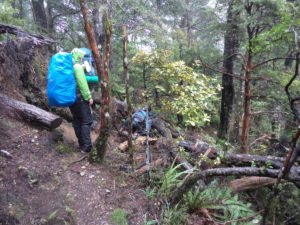
At one point I come across a grey rifle, scope and all. It’s just sitting there, on the side of the track. The girls didn’t see it; I wait for L to catch me up to investigate.
‘There’s a gun’ I exclaim.
‘Oh yea.’ L replies.
I’m not a bushman – does this happen all the time? Do hunters leave guns lying around when they drop a deuce? I don’t know, and I don’t want to nerd out and take a photo incase some grizzled wildman comes out of the bush. I leave it as is.
We’re three or so hours from the trail head when we reach the roar of Smith Stream. The plan is to follow the streambed a kilometre to a hut, have lunch then continue along another kilometre or so to Hinerua hut, where we will spend the evening. But it’s still raining; we don’t wait about.
Sarah leads the way, splashing through the numbing waters of the stream and pushing through the cutty grass on either bank. It’s too high to follow directly, so we criss-cross the stream constantly, scrambling along whichever bank is more amenable. It’s hardest for Sarah and B; their paths lead my way with L patiently behind me. But even then it’s tough going. The barbed vines of bush lawyer arrest our progress on the banks. Our legs are lacerated, our fingers flayed. Every metre we move downstream, the stream is higher, stronger (more productive) and our energy ebbed.
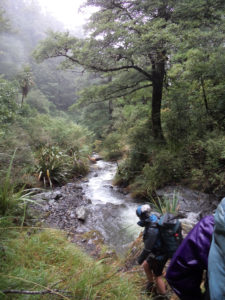
It takes us an hour to move the kilometre down stream. Our grouping is wide, each of us in our own little world of coping. Just as I start to think ‘this is a bit shit actually’ (type 3 fun?) I hear a cheery ‘yaaaaaay!’ ahead of me. Soon I arrive to see the cause; it’s the big orange marker; it’s the track to Smith Stream hut. We’re halfway done with this stream scramble, thank goodness. We eagerly scramble up the bank and arrive to the hut at about 2pm.
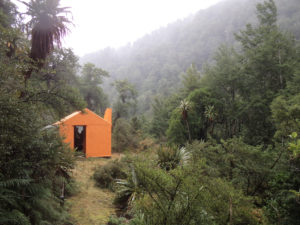
Smith Stream hut will forever stay with me. This squat little orange beacon of reprieve from our journey, we pile in and strip from our wet gear.
Preparing her lunch, B looks thoughtful. ‘Maybe we should just stay-‘
‘YES’ we agree in unison.
B rationalises the decision – “we cross a fork in the stream next, and it’ll be too dangerous with the extra catchment”. Flexibility is a tool for survival, and the hut afforded us the option. I don’t know of these considerations – I’m just happy to be warmer. We set ourselves up for the eve, hanging our clothes from the eaves and trying to keep our dripping gear to one corner of the hut.
The hut is old forestry service, a kitset unchanged from when it was built for the deer cullers in 1958 and the ‘best example in the Ruahine’s’. Small shelters to the sides of the door hold piles of wet brush, optimistically ‘drying’ for use on the open fire.
After lunch, Sarah gets to work on lighting the fire. She quickly discovers the rain coming straight down the chimney has soaked the wood tidily organised by the last DOC ranger, aside from four pieces to the side. One by one, we burn the treats left by prior visitors trying to get the fire going. Tea lights, chunks of fire starter, the box from my coffee bags, quickly-sodden toilet paper. We all have a go, and its Sarah’s second run at it, white spirits from the cooker and a fullsize candle which finally gets it sizzling under its own heat. L is forgiven for thinking the fire is still dead; aside from a light smell of smoke, it proves to be for ambiance only with 99% of the heat heading straight up the chimney.

Wearing every piece of dry clothing left to me (including rainpants) I am still cold. We drink tea and flick through the reading material – a 2008 copy of More Pork, a large-print pig hunting magazine. As we read the articles to one another, I wonder how many people this dog-eared, mouldy mag has helped pass the time.
We have nachos for dinner; they are wonderful. It’s amazing how much warmer one can feel on a full stomach.
The hut visitor book is a treat. “So many f*ckin RATS!” writes one.
“Had to turn back from the ‘track’ to Hinerua” wrote another, the quotes vindicating our decision to stop.
B brought Crocs with her; we all get use out of them, on wee expeditions from the hut. The longdrop is flooded, and with fear of vile longdrop splashback, we use the hut shovel to take care of things instead.
At 7pm we decide to retire; we have a long day ahead. Even in my sleeping bag I am cold; sleep is poor.
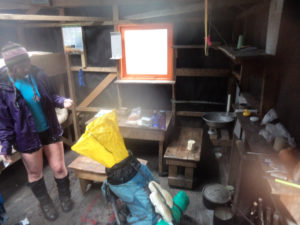
Day Three
We awake early for coffee and porridge. Mercifully the rain has stopped overnight, and outside the grass cracks underfoot with an icy frost. But we know the stream is still dangerous; we opt to head up the ridge, bypassing the ‘track’ to Hinerua hut and getting to Daphne Hut directly in the evening; an expected 10 hour day.
We avoid our sodden clothes as long as possible but we eventually must protect our dry gear and don them; then there is was no time to wait. We have to move or freeze. We leave candles, gather wood for the ‘drying piles’ and, toes already numb, leave the hut and begin to climb.
It’s a different forest this morning, without the persistent rain. Birds find it nice enough to sing; it’s quite pleasant, aside from the clothes.
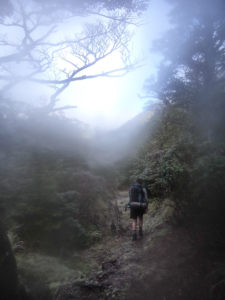
Soon we reach the tree line, and we’re treated to mild sun and chilling breezes. The rock is shattered up here, constantly broken by ice. Some gravel is spongey; each grain of sand held aloft by inches of ice pillars. Other gravel is immobile; it’s solid ice beneath.
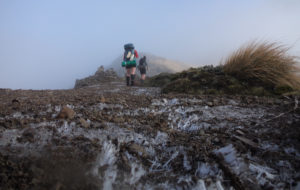
We snack often; the climb and cold keeps our bodies working hard. Soon we are on the tops.
We hear the drone of a helicopter swooping the gullies. Are the other groups alright? We worry, until we see the chopper leaving with two deer carcasses hanging from it sometime later.
We see Ruapehu and Ngaruhoe at a summit before the clouds close in, and then we head south from peak to peak. It’s a tough slog; the rock is sharp and shattered from ice and snow, but fortunately much of both are absent on this trip. Huge areas are just sliding gravel.
On one ridge ahead, we glimpse a great castle of unbroken rock. It appears impassable and foreboding. ‘There’ll be a way around once we get there’ assures B.
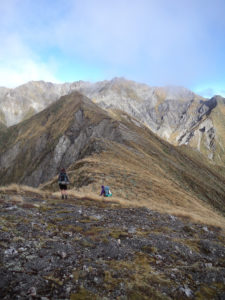
There isn’t a way around. We inspect every angle and come up wanting. There’s no option; we scramble down the scree 100 metres to get around it, then scramble up the other side. Amongst the gravel there’s one thin strip of tussock which hasn’t slipped away. We use it to haul ourselves up. The gradient is 0.5:1, it’s such a toll to reclaim the height we lost. I am cold, tired and hungry, and I find myself on my knees, just staring at the tussock infront of me. Is this what hitting the wall feels like? There’s nothing for it though; we’re committed. I gather myself, reach the top shaking and join the others for lunch.
Sandwiches eaten, I pull out a chocolate bar. The caramel is freezer-solid.
“This next bit, we aren’t going to be able to stop for maybe an hour, so be ready” I’m told. My fear finds me in need of a lavatory, but I make do with the grandest toilet view I’ve had.
We scramble down steep scree, kicking loose great boulders, keeping a distance to ensure we don’t drop them on those ahead.
It’s hard going; they’re steep and erroding ridges. Every now and then, steep slips to the side have us worry about making one false step. We try to stay vigilant, but it’s hard to keep an adrenaline fear awareness for five straight hours.
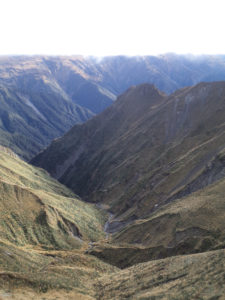
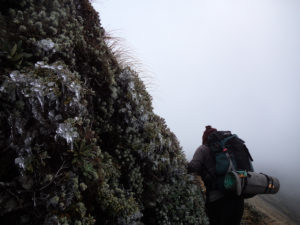
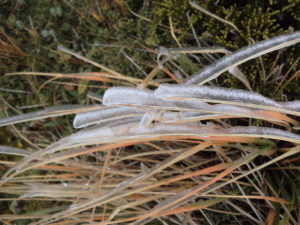
Sarah and B are our navigators. We make good progress on the ridges, but the clag (cloud) moves in, obscuring the view and our route ahead. They rely on taking bearings and ‘put red in the shed’ frequently. L and I loiter about; we can’t help, and it’s best to keep out of the way as the daylight ebbs.
We plod on; we have many hours ahead. We’re to head down Broken Ridge; it’s forever another peak away.
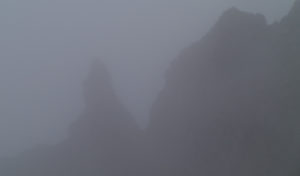
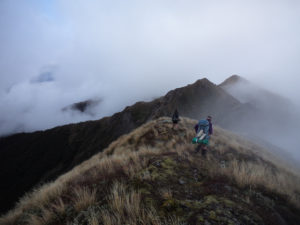
The map says we’re to pass a couple of tarns (small mountain lakes) before coming upon the two-person Tarn Biv. The hours pass, but tarns do not. ‘They must have dried up’ we decide.
On we plod, eventually finding the marker leading down into the bush. We must have missed the biv. ‘It must have been removed’ we decide.
We don our headlights in the bush, and shortly come across a signpost; ‘Hinerua Hut: 10 minutes’.
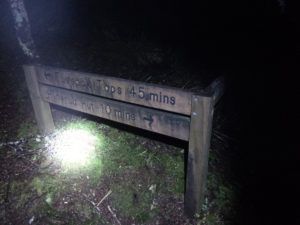
Our concern for a wrong-turn is tempered by the thought of a hut in 10 minutes. We stumble on, and come across the welcoming glow of Hinerua hut ahead. There’s sound from inside; we pop the door and warm greetings are shared; it’s one of the other groups, also off-plan.
Hinerua Hut is the same vintage as Smith Stream Hut, but upgraded in 1993. The steel bunks are attached to the wall and have enough room to cram stuff beneath; there’s a woodburning stove, a sink and 10 tired but thankful people finding places to rest.
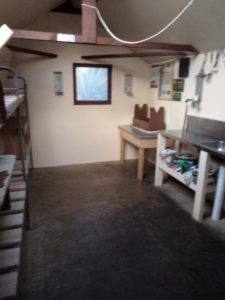
We get dinner going (curry) and study our map; we came down a ridge too soon. We took ten hours to get between Smith Stream Hut and Hinerua Hut; a supposedly two hour distance. But it’s a blessing really; we would have had some long dark hours on the tops and bush ahead should we have followed our intended route.
After dinner we socialise. Again I just stare unseeing, mute.
Mercifully everyone wants to go to bed early. The table and benches are stacked and six bedrolls are laid on the floor. I use my jersey as a pillow; Mum made it, it’s warm, comforting and smells like a sheep.
Day Four
We awake early; two of the other party are leaving early to reshuffle cars at various road-ends so we can all get home. One is A from the previous tramp; it is nice to cross paths again.
We eat and clean up. Retrieving my socks from the rafters, I see I hung them over a packet of rat poison. The message ‘please take to Smith Stream Hut’ is scrawled across it.
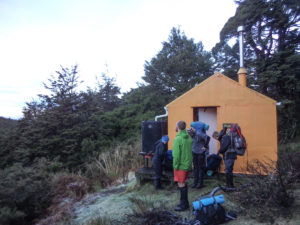
We drop from Hinerua back to Smith Stream, to retrace our steps from Saturday. Quickly the comments in Smith Stream Hut’s visitor book about the “track” prove to be spot on. It follows a creek, but great slips have fallen into the gully at consistent intervals. Fallen logs and debris block our way time and again. Sarah and B take particular routes; L and I take others, as our longer legs allow.

At one point one large slip loses the track entirely. We scramble up the scree, trying to find any indication of anyone elses’s route. Soon we are forging our own path, sliding down the cliff in search of the water again. But this time we’re heading up-stream; it gets easier and easier. The gully opens out and it’s quite fun.

I’m curious whether the rifle is still there; it isn’t. I wonder whether I imagined it, before remembering L saw it too.
Soon we are out of the bush, back to familiar countryside.
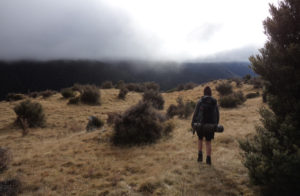

We reach the trailhead to find our car where we’d left it. There’s a little note under the windscreen wiper, left by the advance team who’d returned it 30 minutes earlier.
‘Hope you had a nice walk’.
